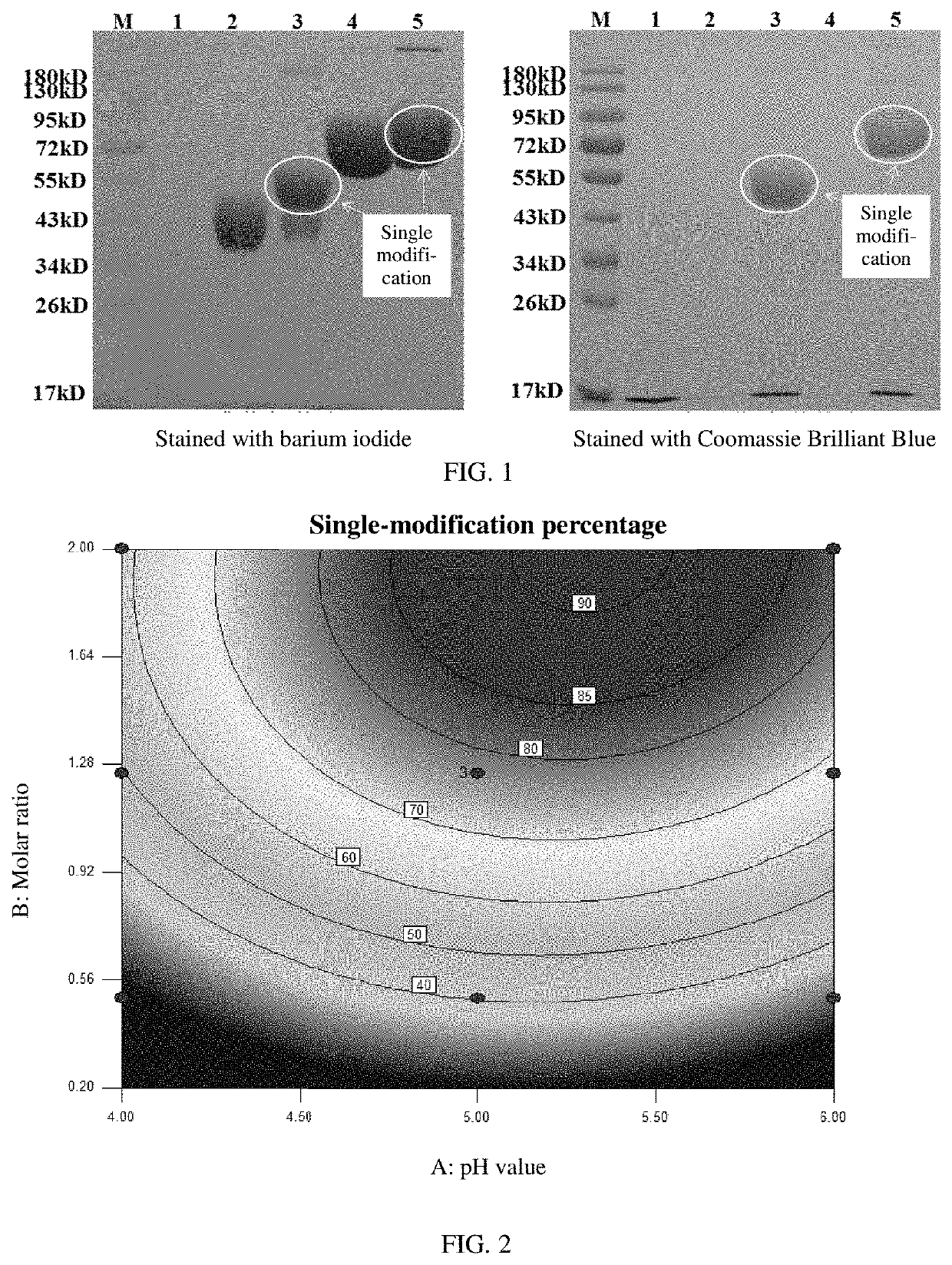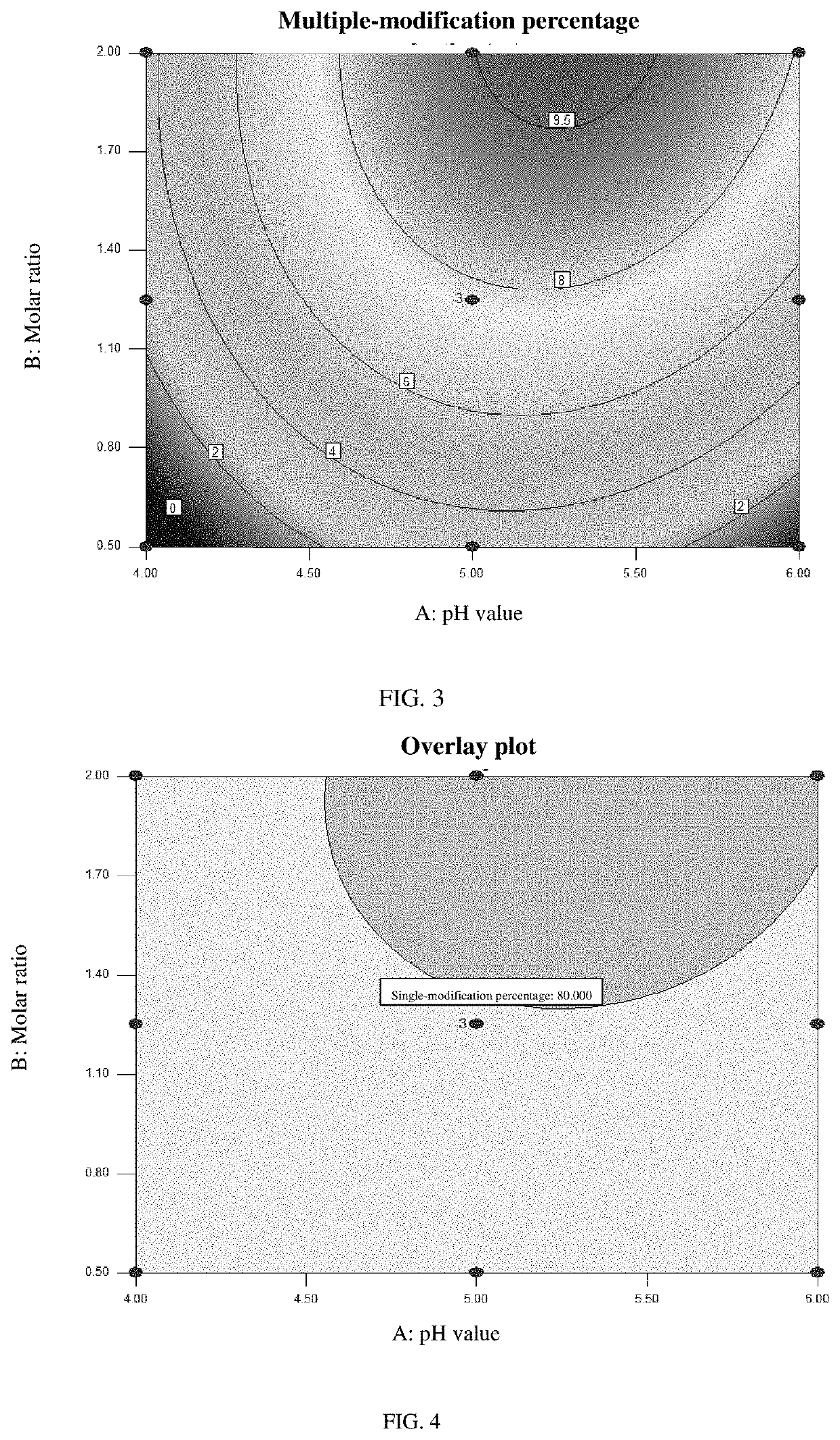Modified recombinant human nerve growth factor and method for preparing the same
- Summary
- Abstract
- Description
- Claims
- Application Information
AI Technical Summary
Benefits of technology
Problems solved by technology
Method used
Image
Examples
embodiment 1
lymer Reacting with rhNGF to Produce Modified rhNGF
[0043]Reaction 1: Preparation of modified product LAP2-20K (1)
[0044]A pH 5.5 acetic acid / sodium acetate buffer solution system was added with 5 mL of rhNGF primary liquid of SEQ ID NO. 1 such that the system had a protein content of 0.5 mg / mL.
[0045]Sodium cyanoborohydride was then added until a final concentration of 20 mM was reached.
[0046]After that, a formula-A polymer of a molecular weight of 20 kD (of formula A-20K) was added such that the molar ratio of the polymer to the rhNGF was 1:1.
[0047]The aforesaid reactants were allowed to react at 5±3° C. for 16 h.
[0048]The reaction mixture was subjected to an SDS-PAGE test, in which samples were separately stained with barium iodide and Coomassie Brilliant Blue. The test results are shown in FIG. 1.
[0049]Reaction 2: Preparation of modified product LAP2-40K (1)
[0050]The method was the same as reaction 1, except that a polymer of formula A-40K, which had a molecular weight of 40 kD, wa...
embodiment 2
sponse Surface Methodology for DOE to Optimize the Reaction Conditions for Modifying rhNGF with Formula-A Polymer
[0058]An experiment for investigating the effect of the pH value of the buffer solution and of the molar ratio of the formula-A polymer (of formula A-20K or formula A-40K) to the rhNGF on the modification percentages was designed by the response surface methodology for DOE, with the single-modification percentage and the multiple-modification percentage being the response values. The modification percentages of the samples were measured by SEC-HPLC (size exclusion chromatography-high performance liquid chromatography).
[0059](1) DOE test results corresponding to a reaction in which an rhNGF is modified by a polymer of formula A-20K
[0060]The modification percentages of samples corresponding to different conditions were analyzed by SEC-HPLC and are shown in Table 1.
TABLE 1Modification percentages corresponding to rhNGF modification by a polymer of formula A-20K, as obtained ...
embodiment 3
f the Preferred Reaction Conditions Selected from the DOE Test Results for rhNGF Modification
[0069]Based on the modification conditions (pH value and molar ratio ranges) of LAP2-20K and LAP2-40K as selected by the response surface methodology for DOE, a test for validating the selected modification conditions of LAP2-20K and LAP2-40K was designed as shown in Table 3.
[0070]The modification percentages of the samples were determined by SEC-HPLC, and the results are also shown in Table 3, in which it can be seen that for LAP2-20K, a single-modification percentage >83% and a multiple-modification percentage 85% and a multiple-modification percentage <12% were achieved with a pH value of 5.25-5.75 and a molar ratio of 1.7-2.0:1.
TABLE 3SEC-HPLC-based validation of the selected modification conditions of LAP2-20K and LAP2-40KSingle-Multiple-Molar ratiomodificationmodificationpH(Formula percentagepercentageConditionvalueA / rhNGF)(%)(%)LAP2-20K-a 5.01.5:183.2358.8449LAP2-20K-b 5.01.8:185.3162...
PUM
| Property | Measurement | Unit |
|---|---|---|
| Molar density | aaaaa | aaaaa |
| Reaction temperature | aaaaa | aaaaa |
| Reaction temperature | aaaaa | aaaaa |
Abstract
Description
Claims
Application Information
 Login to View More
Login to View More - R&D
- Intellectual Property
- Life Sciences
- Materials
- Tech Scout
- Unparalleled Data Quality
- Higher Quality Content
- 60% Fewer Hallucinations
Browse by: Latest US Patents, China's latest patents, Technical Efficacy Thesaurus, Application Domain, Technology Topic, Popular Technical Reports.
© 2025 PatSnap. All rights reserved.Legal|Privacy policy|Modern Slavery Act Transparency Statement|Sitemap|About US| Contact US: help@patsnap.com



